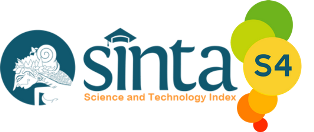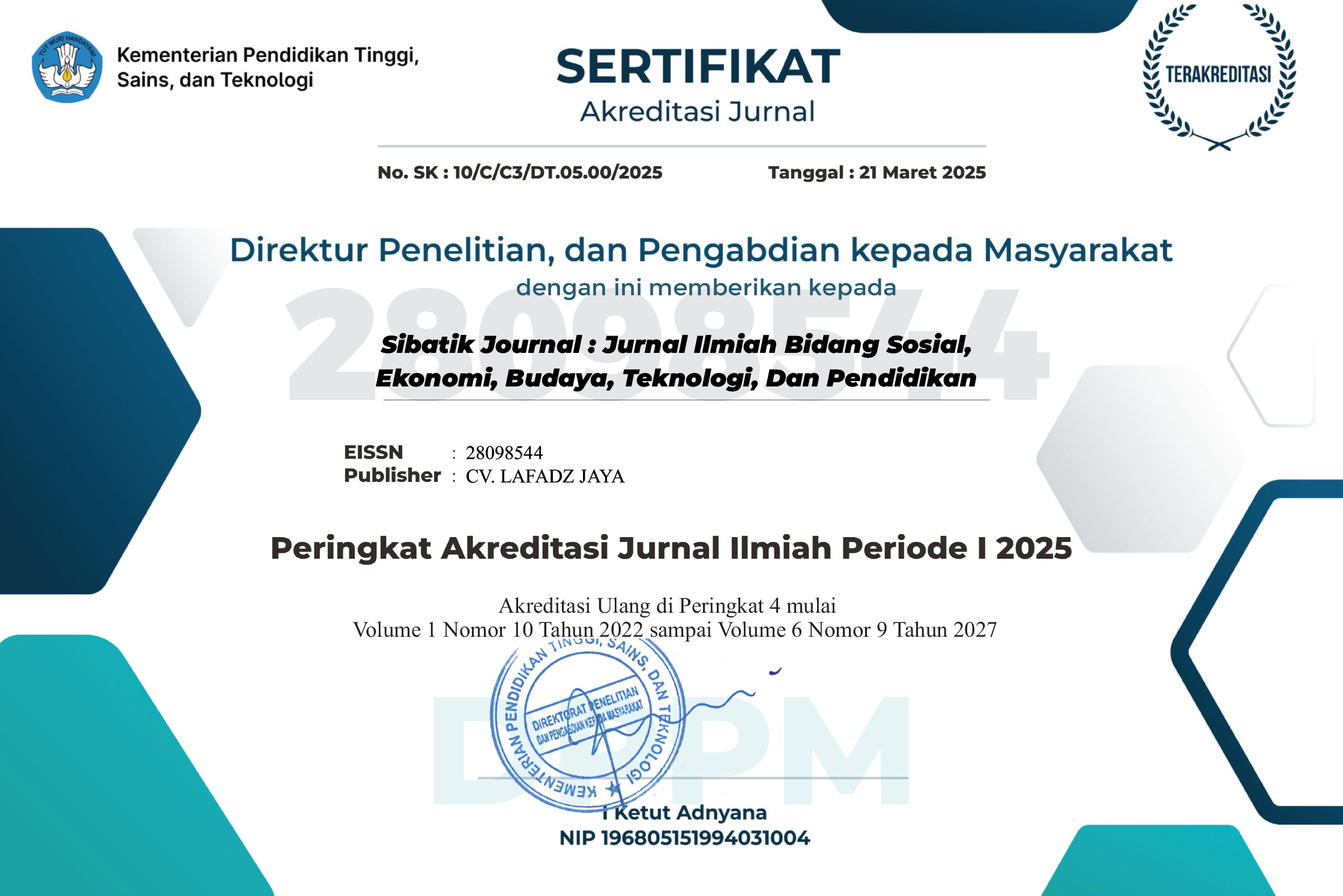ANALYSIS OF THE EFFECTIVENESS OF DIFFERENTIATED INSTRUCTION IN IMPROVING STUDENT WELL-BEING IN GRADE VII SOCIAL STUDIES LEARNING AT SMP NEGERI 1 TEGALSARI
DOI:
10.54443/sibatik.v2i10.1415Published:
2023-09-30Downloads
Abstract
One of the transformations of Indonesia education through the Kurikulum Merdeka to create superior Human Resources (HR) is an educational process that places students in a safe, comfortable and happy environment. This can be realized through differentiated instruction with a learning philosophy that favors differences in students. This study aims to analyze the Effectiveness of Differentiated instructionin Improving Student Well-Being of Students in Class VII IPS Learning at SMP Negeri 1 Tegalsari. The differentiated instruction approach respects the differences of students who are very diverse and can respond to all their needs in the learning process as well as accordingly. The method in this study uses a descriptive method with a qualitative approach to analyze a phenomenon that will be examined through the support of literature studies so as to strengthen the results of the research obtained in making conclusions. data collection was carried out with a simple random sample (Simple Random Sampling). The results of this study found that out of 37 samples of class VII students at SMP Negeri 1 Tegalsari, a total of 192, after going through a differentiation learning process both in terms of content differentiation, process, product and learning environment adjusted to their level of readiness (rediness), profile and learning interest. showed very varied responses, namely: 25 students felt happy, 30 students felt comfortable, 32 students were free, 21 students were self-confident, 24 students were independent, 28 students were enthusiastic, and 31 students were communicative. students during learning. Based on the results of this study, differentiated instruction is very effective in increasing Student Well-Being in social studies learning.
Keywords:
Differentiated Instruction, Student Well-Being, Social StudiesReferences
Rose C & Nicholl, M.J. (1997). Accelerated Learning for the 21st Century. Judy Piatkus:London.
Honkimaki, S. & K-alm-an, O. (2012). Approachesto Transition Support for First Year Students in Higher Education.’ In P. Tynj€al€a, M.-L. Stenstr€om & M. Saarnivaara (eds), Transitions andTransformations in Learning and Education, pp. 247–70. Dodrecht: Springer.
Hardy, I., Decristan, J. & Klieme, E. (2019). Adaptive Teaching in Research on Learning and Instruction. Journal for Educational Research Online, 11 (2), pp. 169–91. doi: 10.25656/01:18004
Prasetyo, G., Joebagio, H., & Yamtinah, S. (2019). Modern Paradigm: Democratic Skills in a Higher Order Thinking Skills Frame. Budapest International Research and Critics Institute (BIRCI-Journal): Humanities and Social Sciences, 2(4), 150–159. doi: 10.33258/birci.v2i4.471
Ireh, M. & Ibeneme, O. T. (2010). Differentiating instruction to meet the needs of diverse technical/technology education students at the secondary level. African Journal of Teacher Education, 1, 106-114. doi: 10.21083/ajote.v1i1.1581
Rahmah, S., A. A. Dalila, W. Liliawati, dan A. Setiawan. 2022. Pendekatan Pembelajaran Diferensiasi dalam Mode Inkuiri Terhadap Kemampuan Numerasi Siswa. Jurnal Ilmiah Pendidikan dan Pembelajaran. 6(2), DOI https://doi.org/10.23887/jipp.v6i2.50838
Hasanah, L. W., H. Silalahi, dan N. B. P. Utama. 2023. Strategi Pembelajaran Berdiferensiasi pada Pembelajaran Matematika Materi Keliling Bangun Datar Kelas IV Sekolah Dasar. Jurnal Didaktika Pendidikan Dasar. 7(1): 237-258, doi https://doi.org/10.26811/didaktika.v7i1.1064
Avcu, Y. E., dan Y. Yaman. 2021. Effectiveness of the differentiated intruction design for value education of gited: a amixed study. Journal of Gifted Education and Creativity. 9(1): 1-23.
Krishan, I. Q., dan M. S. Al-rsa’i. 2023. The Effect of Technology-Oriented Differentiated Instruction on Motivation to Learn Science. International Journal of Instruction. 16(1): 961-982
Tomlinson, C. A. (2017). How to differentiate instruction in academically diverse classrooms (3rd ed.). ASCD.
Tomlinson, C.A. 2000. The Differentiated Classroom: Responding to the Needs of All Learners. Alexandria: Association for Supervision and Curriculum Development.
Tomlinson, C. (2003). Fulfilling the promise of the differentiated classroom: Strategies and tools for responsive teaching. Alexandria, VA: Association for Supervision and Curriculum Development.
Tomlinson, C. A., & Imbeau, M. (2010). Leading and managing a differentiated classroom. Alexandria, VA: Association for Supervision and Curriculum Development.
Tomlinson, C.A. 2015. “Teaching for Excellence in Academically Diverse Classrooms.” Society 52 (3): 203–209. doi:10.1007/s12115-015-9888-0.
Levy, H. M. (2008). Meeting the needs of all students through differentiated instruction: Helping every child reach and exceed standards, Clearing House, 81(4),
Tomlinson, C.A. 2001. How To Differentiate Instruction In Mixed Ability Classrooms. Alexandria: ASCD.
Direktur Jendral Guru dan Tenaga Kependidikan (2023). Platform Merdeka Belajar 1.33.0. Jakarta. Kementrian Pendidikan, Kebudayaan, Riset dan Teknologi
Coubergs, C., K. Struyven, G. Vanthournout, and N. Engels. (2017). “Measuring Teachers’ Perceptions about Differentiated Instruction: The DI-Quest Instrument and Model.” Studies in Educational Evaluation 53: 41–54. doi: 10.1016/j.stueduc.2017.02.004
Johnson, D., and R. Johnson. 2014. “Cooperative Learning in 21st century/Aprendizaje Cooperativo En El Siglo XXI.” Anales De Psicologia, no. 3: 841. doi:10.6018/analesps.30.3.201241.
Slavin, R.E. 1989. “Comprehensive Cooperative Learning Models for Heterogeneous Classrooms.” The Pointer 33 (2): 12–20. doi:10.1080/05544246.1989.9945371.
Kulik, J.A., and C.L.C. Kulik. 1992. “Meta-analytic Findings on Grouping Programs.” Gifted Child Quarterly 36 (2): 73–77. doi:10.1177/001698629203600204.
van de Pol, J., M. Volman, and J. Beishuizen. 2010. “Scaffolding in Teacher–Student Interaction: A Decade of Research.” Educational Psychology Review 22 (3): 271–296. doi:10.1007/s10648-010- 9127-6.
Anderson, J.R., L.M. Reder, and H.A. Simon. 1996. “Situated Learning and Education.” Educational Researcher 25 (4): 5–11. doi:10.3102/0013189X025004005.
Sebihi, A. (2016). Strategizing teaching: Differentiated teaching style and learning brain. EPRA, 4(12), 115-118
Aliakbari, M., & Haghighi, J. (2014). On the effectiveness of differentiated instruction in the enhancement of Iranian learners reading comprehension in separate gender education. Procedia-Social and Behavioral Sciences, 98, 182-189.
Firwana, S. S. (2017). The effect of differentiated instruction on learning English vocabulary and grammar among second graders in UNRWA schools (Unpublished doctoral dissertation) The Islamic University, Gaza
W. S. Winkel, 2009, Psikologi Pendidikan dan Evaluasi Belajar, Jakarta: Gramedia
Amato P. R., & Gilbreth P. R. (1999). Nonresident fathers and children's well-being: A meta-analysis. Journal of Marriage and the Family, 61, 557–574.
Soutter, A. K. (2012). Students’ and teachers’ perspectives on wellbeing in a senior secondary environment. Journal of Student Wellbeing March 2012, Vol. 5(2), 34–67.
Rice, F. P., & Dolgin, K. G. (2008). The Adolescent: Development, Relationships, and Culture.Boston: Pearson.
Sugiyono, metode penelitian kualitatif, kuantitatif, R&D (Bandung: alfabeta, 2016)
Salim, & Haidir. (2019). Penelitian Pendidikan: Metode, Pendekatan, dan Jenis. Jakarta: Penerbit Kencana.
Sugiyono, metode penelitian kualitatif, (Bandung: alfabeta, 2017)
Azizah, D. (2016). Penerapan differentiated instruction terhadap kemampuaN berpikir kreatif peserta didik. Delta: Jurnal Ilmiah Pendidikan Matematika, 4(1), 1-8. http://dx.doi.org/10.31941/delta.v4i1.1017
Setiyo, A. 2022. Penerapan Pembelajaran Berdiferensiasi Kolaboratif dengan Melibatkan Orang Tua dan Masyarakat untuk Mewujudkan Student’s Well-being di Masa Pandemi. Jurnal Ilmiah Biologi. 11(1): 61-78, DOI https://doi.org/10.26877/bioma.v11i1.9797
Hidayatishafia, D. & Rositawati, S. (2017). Hubungan School Well Being dengan Student Engagement. Vol 3, No 1, Prosiding Psikologi (Februari, 2017). DOI: http://dx.doi.org/10.29313/.v0i0.5941
License
Copyright (c) 2023 Nanin Pasroni

This work is licensed under a Creative Commons Attribution 4.0 International License.












